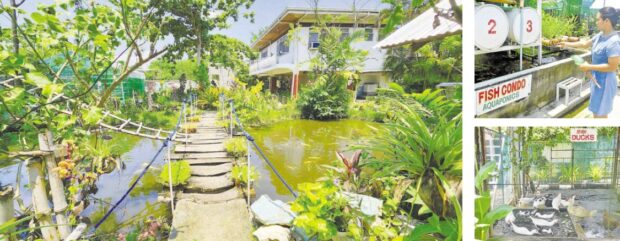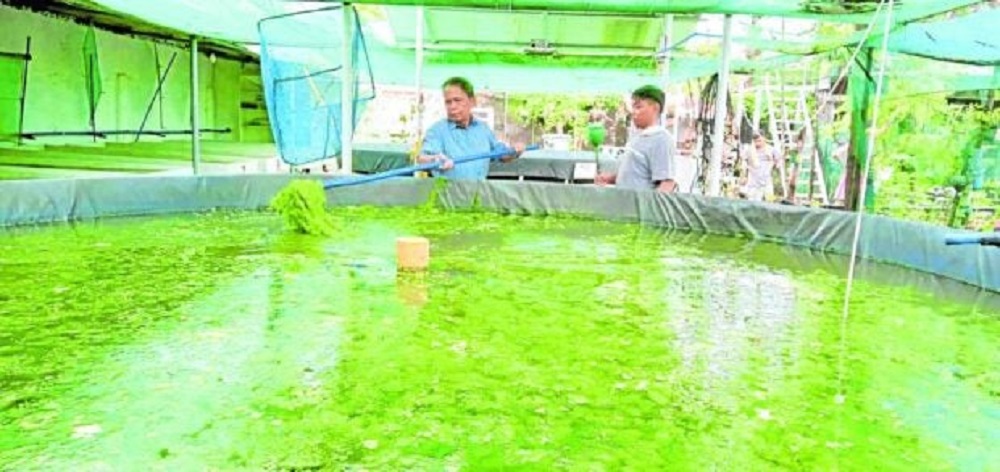Transforming an empty, unproductive 1,000-square-meter backyard in his family compound at Tapuac District here has given Westly Rosario, former chief of the Bureau of Fisheries and Aquatic Resources (BFAR) Research Center in this city, a good reason to continue with his passion for fisheries education after his retirement from government service.
“The place was overgrown with weeds, with only an old mango tree standing there. No one went there because many believed that it was ghost-infested,” Rosario said in jest during an interview this week.
That image is far from how the backyard looks now — every space is used and converted into several ponds for different aquatic plants and fish.
The area now hosts an aquaponics system, a “fish condo,” an earth pond traversed by a mini bridge and enclosures for native chickens, ducks, and a wild pig.
Despite retiring from government service in 2020, Rosario’s passion for fishery and food production never waned, and he continues to teach anyone interested about the industry, right in his backyard.
His backyard urban farm, called FishTech Philippines Inc., was accredited by the Department of Agriculture-Agricultural Training Institute (DA-ATI) as a learning site for aquaculture and agriculture in 2020. It was upgraded to an agriculture and fisheries extension service provider in January 2023.
“I wanted to ensure that there is life after retirement. I earlier planned what I would do to keep me busy after I retire. And since all [throughout] my professional life I worked in fisheries, it was only logical that my post-government work would be on fisheries,” the 67-year-old Rosario told the Inquirer.
At the farm’s entrance, just right after an azolla pond, is a signboard that reads, “Urban Aqua Farming, Tuloy Po Kayo (You’re welcome).” Immediately, this makes anyone who comes for a visit or study feel the relaxing vibe of a provincial farm in the heart of an urban community.

OASIS | The 1,000-square-meter FishTech Philippines demonstration farm features an earth pond where giant gourami, red and regular tilapia, “pangasius” and African catfish are raised.A“fish condo” that also features aquaponics is the farm’s major showcase (upper right). Chickens and ducks are also raised there and are fed with aquatic plants (lower right). (Photos by WILLIE LOMIBAO / Inquirer Northern Luzon)
Food production
“Whatever fishery technologies I have learned, I apply here. I wanted to show that in even small areas, one can establish a farm that can produce food for the family, and even earn from the sale of the produce,” Rosario said.
The farm, he says, is “integrated,” as it produces azolla, a type of aquatic fern, and kangkong (water spinach) to feed fish and animals. Waste from the farm’s fish and animal stock, in turn, is used as fertilizer.
A major “showcase” at the farm is the “fish condominium,” or stacked drums, where fish are cultured. Rosario developed this technology, called “fish-base integration,” when he was leading the BFAR Research Center.
Aquaponics, another system that produces fish and vegetables, is featured beneath the fish condo.In the fish condo technology which primarily produces fish, used water passes through simple mechanical filtration, or through the pipes planted with kangkong, said Rosario.
Water is pumped into the top containers or drums filled with beach sand and volcanic rocks which cleanse the water, making it safe for the fish. The kangkong further cleanses the water through a process called biological filtration, Roario said.
On the other hand, aquaponics’ main crop is vegetables, with the fish used to enrich the water with nutrients. Waste excreted by the fish and unconsumed feed are converted into nutrients for the plants.
Both systems produce red tilapia and kangkong.
“We use kangkong in the systems because it has lots of roots, so it cleanses the water well. Water lilies are also effective, but they can’t be consumed by humans,” said Rosario.
FishTech does not sell its produce, except for azolla. A total of eight ponds, measuring 1 meter by 3 meters each, are dedicated to its production.
The farm, he said, is not operating commercially as it is used primarily as a laboratory for azolla culture.
Rosario said he learned about azolla while working at BFAR in Nueva Ecija province. “I learned the importance of azolla in other countries as fertilizer and fish and animal feed, but BFAR was focused on duck weeds then,”
So when he developed his backyard, he put up simple demonstration ponds to show how easy it is to grow azolla.
“I sell [azolla] at P100 per kilo, but not really for commercial purposes. I only wanted to give value to the aquatic plant to show that farmers and fishermen can earn from cultivating it. Otherwise, if these are acquired for free, they take it for granted and would not grow it,” he said.
He said many who come to his farm buy azolla to start their own ponds.
Azolla does not need processing and is just given after harvest to the fish and the animals. Also known as mosquito fern, azolla is a versatile aquatic plant. Aside from being animal feed, it can be used as a biofertilizer on a variety of crops, as medicine and as a water purifier. “I read somewhere that azolla is consumed by people in other countries, but not in the Philippines yet,” he said.
Azolla, according to Rosario, is also called mosquito fern because mosquitoes cannot thrive on ponds or other bodies of water where it is grown. “Azolla covers the entire surface of water, preventing mosquitoes from penetrating through to the water to lay eggs,” he said.
Hydrilla, also an aquatic plant, is widely grown on the farm. It is used as feed for native chickens and ducks, and for a lone native pig, which Rosario calls “a survivor of African swine fever.”
As for the fish produced in the farm, Rosario said these are not sold but treated like pets.
He harvests kangkong and alugbati for consumption by family members and their workers. The rest of the harvest is fed to the pig and ducks in the farm.
Earth pond
Another interesting spot on the farm is the earth pond, crossed by a mini bridge, where giant gourami, red and regular tilapia, pangasius, and African catfish live together. There are also two azolla floating beds to demonstrate that the plant can be grown in ponds with fish, as long as there is a net below the floating beds.
Deep in the farm is a pandan plantation, a “WesCafe” corner and a tower that overlooks the farm and where camote (sweet potato), alugbati and some ornamental plants, are grown in recycled containers.
“I wanted to show that one can grow vegetables in empty water containers or cans. In a corner of the tower is an old yellow bathtub into which water from the earth pond is pumped, so there’s no need to fetch water below for the plants grown there,” Rosario shared.
“We have pandan in the farm and this is used in our bottled bangus. We grow eggplant, chili, okra, katuray, and kamias for family use. We have a supply of duck eggs from our ducks, which are fed with azolla and kangkong,” he said.
Rosario said that after the farm was established, it did not need much funding to sustain operations.
Sometimes he hires senior high school students as helpers, but only during school breaks. Usually, he does all the farm work, like watering the plants and feeding the fish and chickens.
FishTech also produces Doc West Bio (Fish) Fertilizer, an organic foliar fertilizer produced from fish heads, tails, fins, scales and innards, which are discarded from a mini factory producing bottled bangus and run by Rosario’s wife Joy. The foliar fertilizer is sprayed directly onto the leaves to improve plant health, stimulate root development, increase resistance to pests and increase harvest.
The DA-ATI gave him a grant of P150,000 to start the aquaponics system and fish condo. Rosario is regularly invited by the DA-ATI to train extension workers, and by private fish farm owners to lecture about fishery technologies. His professional fees are set aside for the farm’s expenses.
Rosario said anyone interested in learning about fishery technologies could visit the aqua farm and he would gladly sit down with visitors.
“[My experience demonstrates] how a family can have a sustained supply of basic plant crops, fish, few poultry and livestock in an urban-backyard farm,” he said.
“Life goes on for a retired senior citizen like me. It is very relaxing to share my experiences, and I am happy to stay connected to former colleagues and workmates who come and ask for advice,” he said.
Source : Inquirer.net

